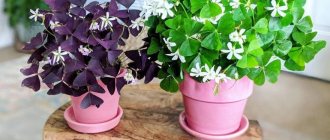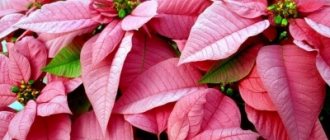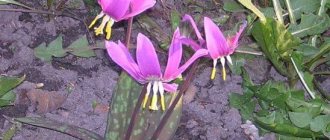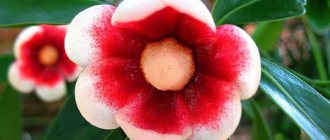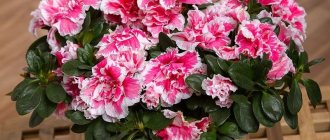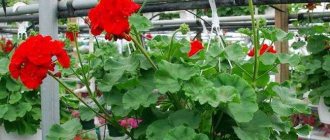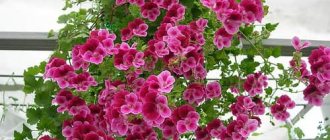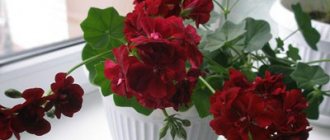Pelargonium Grandiflora: main features
The main difference between large-flowered pelargonium and other varieties is the structure of the flower and the type of foliage.
The bud is formed by 5 petals - 3 large upper ones and 2 smaller lower ones, while the diameter of the flower when fully bloomed can vary from 7 to 15 cm, depending on the growing conditions and the qualities of the variety.
The leaves are characterized by jagged edges, high plate density, roughness and the absence of a “geranium” aroma.
The height of an adult bush reaches 30-60 cm, the crown is covered with bright caps of a wide variety of colors, from snow-white to burgundy and purple shades.
The flowers are most often double, but there are also varieties with simple inflorescences.
Individual specimens look very impressive - the presence of a dark spot in the center or stripes along the petals, as well as slight waviness or corrugation of the edges turn the buds into a real work of art.
The inflorescences of Grandiflora pelargonium are at the same level with the foliage, and do not rise above the crown, as in zonal and other varieties.
The formation of flower buds occurs in March, the budding period ends in the second half of summer.
Thus, you can admire the caps for 3-4 months, but even during this time, pelargonium can show a capricious disposition and drop its inflorescences.
The success of cultivation is largely determined by the stability of conditions, agricultural technology and care.
Description of pelargonium species
There are many types of pelargonium, the most popular of which are pelargonium domestica, fragrant, capitate, zonal, grandiflora and thyroid. The description of pelargonium of different species is largely similar, but there are also a number of differences.
Fragrant pelargonium (Pelargonium graveolens) is an evergreen perennial light-loving plant up to 1 m high. The entire plant has slight pubescence. The stems are light green, highly branched, woody in the lower part. The leaves are green, five to seven lobed, with uneven wavy lobes, fragrant. The flowers are small, lilac-pink, collected in umbrella-shaped inflorescences. Blooms in summer.
Pelargonium capitatum (Pelargonium capitatum) is an evergreen plant, a densely pubescent subshrub 0.5-0.6 m high. The shoots are straight, widely spread. The leaves are three to five lobed, serrated, with a pleasant aroma. The inflorescence is a multi-flowered umbrella. The flowers are sessile, purple-pink. Blooms in July-August.
If you open the description of zonal pelargonium in other sources, then this plant has a name in Latin. It was appropriated due to the fact that the perennial fruit looks like a stork's beak. In Latin the name looks like this: Pelargomium Zonale. In Europe, a small bush appeared in the 17th century. It was brought from tropical Africa, where it spread to the southern part of the continent.
Until the 18th century, the plant was very popular, but after that, due to its rapid spread, it was classified as a bourgeois plant. Despite its characteristically long and abundant flowering, pelargonium is no longer widely grown in the gardens of high-ranking officials. However, today it is a very popular indoor flower and is completely unpretentious.
READ MORE: Do-it-yourself country paths from scrap materials 66 photos of how to make garden or country paths from scrap materials Zonal pelargonium and the external environment
| Lighting | Watering | Reproduction | Rest period |
| Bright, at least 12 hours during flowering | Regular, portioned | Cuttings, seeds | In winter, no more than 3 months |
Royal pelargonium is a close relative of the zonal variety of the crop. But it cannot be found in natural conditions, since it was obtained as a result of crossing other species. Therefore, the plant differs from its fellows not only in external characteristics, but also in its whimsical conditions of detention.
Pelargonium grandiflora features exquisite flowers
The first varieties of grandiflora appeared at the end of the 18th century and were of English origin. They were obtained by improving the flower size of common species that were introduced from the Cape Province of South Africa.
But already in 1834, French breeders made their own adjustments to the process of obtaining royal pelargonium. Therefore, during this period, varieties and species with contrasting veins and two bright spots on the upper petals appeared. This group of royal pelargoniums was named Diadeatum.
The decisive step in the selection of grandifloras was taken by the gardener James Odier, who managed to ensure that the veins on the petals turned into spots, and in the end there were 5 of them in the flower.
Peculiarities
Geranium grandiflora, as the flower is sometimes mistakenly called by ordinary people, forms a bush up to 50 cm high and at the same time grows wider than upward. Its leaves are densely located on the shoots. The plates are large, round, rough to the touch, jagged along the edge. They can be light or dark green. The root system is fibrous.
Grandiflora bushes are compact
The royal variety has flowers with 5 petals. Moreover, the top three are much larger, and the bottom two are smaller. The petals overlap each other. Flowers can be simple or double. The color of the petals is very diverse: from white, pink and orange to red and dark cherry. The petals may be corrugated and wavy, and have a bright spot or stripes.
Attention! The difference between grandifloras is that the peduncles do not rise above the foliage, as in other species, but are located at the same level. During the flowering period, the bush is an unforgettable sight, which is why flower growers fell in love with royal pelargonium.
Due to the high decorative qualities of the plant, it is widely used to decorate glazed balconies, terraces, loggias and home interiors. The flowering period of grandiflora begins in April-May and lasts for 3-4 months, depending on the conditions of detention.
At the same time, pelargonium grandiflora is not intended for growing in the garden, since it does not bloom in open ground.
The plant is characterized by rapid growth - at the end of the first season you can get a compact bush 20-30 cm high, and already in the next season royal pelargonium reaches a standard size. As they mature, the shoots become lignified at the bottom, as in other species.
Important! The grandiflora variety does not have the characteristic smell of pelargonium, but some varieties during flowering exude a delicate aroma combining shades of rose, lime and mint.
Home care
To get a compact and decorative bush of crown-flowered pelargonium, you need to take care of lighting.
This variety of geranium loves light, but does not tolerate direct sunlight, so the best place for the pot will be eastern and western window sills.
On the south side, the plant will have to be shaded - the scorching sun causes irreparable damage to the foliage.
Northern window sills are not suitable - low illumination leads to loss of attractiveness of the bush, elongation of shoots and lack of flowering.
The optimal range during the active growing season will be +22–+25 degrees; during winter, it is better to keep royal pelargonium cool at +12–+16 degrees.
The plant loves fresh air, but does not tolerate drafts and sharp gusts of wind, which often provoke severe stress and even death of the specimen.
Humidity is important for large-flowered pelargonium, so in hot weather it is recommended to spray the air around the bush with a fine spray bottle. Drops of water should not accumulate on the foliage, especially if the plant is under the sun.
The agricultural technology of pelargonium Grandiflora comes down to the following points:
It is necessary to moisten the soil frequently and abundantly, without allowing the earthen clod to completely dry out. This variety of geranium does not react well to soaking soil, so it is necessary to drain the moisture from the tray.
For irrigation, it is better to use warm or room temperature settled water;
For lush flowering, pelargonium needs a sufficient amount of nutrients, which are recommended to be added 2-3 times a month.
As a fertilizer, it is better to use special fertilizers for Geraniums or universal formulations for flowering indoor plants.
The content of potassium and phosphorus should be maximum, and the percentage of nitrogen should be minimum;
Pelargonium Grandiflora does not tolerate replanting with a complete replacement of the soil, so it is better to replace it with a more gentle transshipment.
The procedure is carried out approximately once a year or two, depending on the condition of the root system (the roots should completely entwine the earthen ball).
The diameter of the pot is increased by 1-1.5 cm, giving preference to small containers.
The soil should include leaf and garden soil, humus, perlite or sand, peat in equal quantities with the addition of charcoal or activated carbon.
Wintering for large-flowered pelargonium is mandatory - without rest, the plant will not be able to bloom well in the next season.
After flowering ends, fertilizing is stopped, and preparation of the bush begins in October.
For the winter months, the pot is transferred to the following conditions:
- Temperature - within +12—+16 degrees;
- Humidity is minimal; watering is reduced for this purpose;
- The lighting is strong, placed on a sunny windowsill or illuminated with lamps.
It is not recommended to apply fertilizers during wintering - the components of fertilizing cause early shoot growth.
Return pelargonium to its usual conditions in the second half of February, resuming full care.
Pruning Pelargonium Grandiflora
To ensure that the bush branches well and grows new shoots, it is regularly pinched as it develops. Heavy pruning is carried out in the fall - the branches are shortened by 1/3 or 2/3 of the length.
It is advisable to complete the procedures for forming the crown after wintering in February, since in March the bush is already laying flower buds and preparing for budding.
During the active growing season, the bush is periodically inspected, removing suspicious, dry and weak shoots. Falling buds should be removed to prolong flowering.
Pelargonium and geranium: what are the differences
Geranium and pelargonium are very similar in appearance. These plants belong to the same geranium family. However, the flowers are different in origin. Pelargonium comes from Africa, geraniums live in the middle zone. This explains the differences in care. Delicate pelargonium does not tolerate frost and sudden temperature fluctuations. She is demanding of lighting, loves hot sun and thrives in the hot sun. Pelargoniums are more diverse in shades and are better amenable to selection. With proper care, plants form lush caps of flowers that look very decorative.
Geranium prefers cooler weather and diffused light without direct sunlight. Geraniums are undemanding to soil and can be planted in open ground.
Diseases and pests of large-flowered geranium
The main enemies of royal pelargonium are whiteflies and aphids, which have a special love for this flower. Pests can be seen on the underside of the leaf, while the larvae are easily distinguishable with the naked eye.
Affected specimens must be isolated and treated with a solution of “Aktara”, “Fufanon”, “Aktellika” or “Teppeki”.
If the pest spreads strongly, it is recommended to use a “shock” dosage. Spraying is carried out at least 4 times at intervals of 4-5 days.
Improper care provokes the development of diseases that harm not only the foliage, but also the root system. Excessive watering with high air humidity and poor lighting causes the appearance of gray rot.
The crown fades, and characteristic rotting spots appear on the leaves.
You can fight rot with Bordeaux mixture or copper sulfate; it is important to adjust the correct degree of soil moisture.
Leaves turn yellow most often when there is a lack of moisture in the substrate, dry air and lack of fertilizing, when the plant does not receive the necessary components.
High-quality agricultural technology and normalization of living conditions will help eliminate the problem.
Pelargonium Grandiflora is a whimsical plant, but its capricious nature fully pays off with spectacular flowering.
Diseases
Unfavorable environmental conditions and violation of care rules provoke the development of diseases. The type of disease can be determined by characteristic visual signs.
Blackleg
A fungal disease often affects immature seedlings. The disease is manifested by blackening of the root collar, the appearance of rotting areas and lodging of seedlings.
Gray mold
If affected by gray mold, dry spots form on the stems. If there is no control, the disease spreads to foliage and flowers.
Leaf rust
A characteristic symptom of leaf rust is the formation of orange or brownish growths. Over time, the growths crack and fungal spores spill out of them.
Powdery mildew
The primary sign of powdery mildew infection is the formation of white mycelium. Plaque occurs on petioles, young shoots and the surface of leaf blades.
Oedema, edema
Oedema appears in the form of small pimply growths. As the disease spreads, the entire side of the leaf blade becomes covered with growths.
Verticillium wilt
The fungus that causes verticillium wilt is found in the soil and can lead to the death of the plant. The leaves of affected flowers begin to curl and bend toward the ground.
Gray rot
Gray rot manifests itself as spots on shoots and leaves. The spots quickly enlarge and become covered with plaque, which consists of spores and mycelium.
Stem and root rot
The reasons for the development of rot are excessive watering and fertilizing. The consequence of the disease is the colonization of the roots by soil-degrading fungi.
Stem and root late blight
Signs of late blight are brown spots surrounded by mold or covered with plaque. The affected areas die off, which causes the death of the plant.
Other problems
In addition to diseases, other difficulties may arise when growing pelargonium. It is worth familiarizing yourself with possible problems in order to try to avoid them.
Leaves turn yellow and dry
Yellowing and drying of leaves is associated with a lack of fertilizing. It is recommended to use complex fertilizers to saturate plants with nutrients in the required quantities.
Wet and loose leaves
The leaf structure deteriorates due to waterlogging or pest attack. Externally, the foliage looks wrinkled and withered.
Pink tan on leaves
This problem may occur due to burning of leaves
It is important to ensure that the green part of the flowers is not burned by the sun's rays
Falling leaves
Pelargonium leaves fall off due to drafts or temperature changes. In winter, partial fall is a natural process.
Pot volume too large
In an unsuitable container, the plant will not develop properly. For small pelargonium you need to choose an appropriate pot.
Excess nitrogen fertilizers
Excessive application of nitrogen leads to disruption of the growing season. Fertilizers should be applied portionwise and in small quantities.
Description of culture
Large-flowered pelargonium is a compact bush, the height of which reaches 60 cm. Its erect stems are shrouded in bright green foliage, and large flowers are located on top, their diameter reaches 7 cm. They are:
- collected in inflorescences 25 cm in diameter;
- differ in various shapes.
The color of the petals can range from white to dark purple. With proper care, the flowering period can last 3-4 months.
Rules of care
The flower will grow well indoors if you provide it with proper care.
The plant loves a lot of light; it is better to place it in the southern part of the house. It is advisable to cover the flower from direct sunlight on hot days. This will avoid burning the foliage.
If the side is western or eastern, it is recommended to place the flower by the window. From the north, lighting should be supplemented with artificial lighting, otherwise the plant will not have enough light. This will result in:
- the foliage will become smaller;
- buds will not form;
- there will be no flowering.
It is also necessary to regularly ventilate the room without creating drafts. During the warm season, you can take the pot out into the garden or onto the balcony.
Temperature
Pelargonium Grandiflora grows well where the air temperature is more than 24 degrees. In winter, it should be maintained at 12-14 degrees. This will allow the plant to bloom well next season.
The flower requires timely watering, the frequency of which varies depending on the room temperature level:
- When it’s hot, you need a lot of water, and excess water should be poured out of the pan regularly.
- in cold weather, watering is carried out after all the soil in the pot has dried.
In normal times, the soil should be moistened after its upper level has dried out. To do this, take settled water at room temperature.
Air humidity
The level of this indicator is not critical for a flower; it can easily survive both dryness and high humidity, but moderate parameters are optimal for the plant. Spraying may not be necessary, as the foliage has a rough surface.
In order for Pelargonium grandiflora to grow actively and bloom profusely, it requires regular feeding. It is especially important to apply fertilizers during the growing season. To do this, use compositions that contain in equal proportions:
For good development, the flower also needs other microelements, which:
- increase his immunity;
- prevent the development of diseases.
Fertilizers are applied once every 2 weeks after the onset of spring and in summer. In winter and autumn, fertilizing is carried out once a month.
Every fall, the bush of the plant is pruned to the base of the roots. Yellowed, dry leaves are removed throughout the year.
Pruning is carried out using:
The cut site is treated using crushed activated or charcoal.
Young flowers are replanted every year. Plants older than 3 years are replanted when the root system fills the entire substrate.
To replant the crop, purchase a new pot, the size of which should be 2-3 cm in diameter larger than the old one. This is important, because if the pot is too spacious, the geranium will not bloom. It will begin when the root system takes up the volume of the entire pot.
A drainage layer is placed at the bottom of the container, thanks to which the water will not stagnate. This will prevent the roots from rotting. Soil needed for planting:
- slightly acidic;
- light;
- well drained.
It is permissible to use the soil for flowering crops of their store. You can form the soil mixture yourself. To do this take:
- part of clean river sand;
- 8 parts of turf;
- 2 parts humus.
The bush is placed in the center of the pot, the free space is filled with soil, it is carefully compacted, and watered abundantly.
How to help the plant?
When the ovary appears, it is important to eliminate obstacles to the formation of inflorescences:
- Flowers in direct sunlight will not be bright.
- In winter, the plant benefits from coolness, but temperatures below 10 degrees will not do any good and will stimulate the plant to awaken prematurely from hibernation.
- A southern windowsill, where there is a lot of sun, is the best place for geraniums.
- For lush flowering all year round, the prerequisites are nutrition and lighting.
- Lots of branches - lots of room for flowering. To enhance branching, shoots are pinched.
- Fading flowers are immediately removed.
- With regular pruning, geraniums rejuvenate and gain strength for growth.
- Geranium grown from seeds blooms four to five months after sowing. During this time, the plant gains vegetative mass.
Necessary conditions for lush flowers
For beautiful, lush flowering, the gardener must comply with several conditions:
- Lighting. Plants prefer diffused light, otherwise the leaves turn red or yellow; if there is not enough sunlight, there will be no flowering.
- Temperature. In winter, the plant needs 13 degrees, otherwise the stems become bare and the foliage falls off. In summer, the temperature is maintained at 18-20 degrees and the pots are shaded. You can plant it on the balcony or take the pot out into the front garden for fresh air.
- Humidity. Maintain soil moisture; spraying foliage is prohibited.
- Fertilizer. In the spring, fertilize twice a month; in the summer, once is enough. When growing indoors, organic fertilizers are not used; phosphorus, nitrogen and potassium are added in equal parts. Do not fertilize in winter or during extreme heat.
Diseases and pests
Even such a beautiful and strong plant can sometimes get sick. Most often found:
- powdery mildew, when a powdery coating forms on the stems and leaves. The flower needs to be treated with Bordeaux mixture and copper sulfate solution.
- leaf rust. When it appears, small spots of a yellowish tint appear on the upper side of the leaves, and rusty-colored pads are visible below. With such a disease, the plant can no longer be saved; it must be thrown away along with the earthen lump. For prevention, well-drained soil should be used, and watering should be done moderately, avoiding low temperatures in the room.
- root rot. It manifests itself by the appearance of brown lesions on the stems of the bush. A gray coating forms on its foliage. With such a disease, it is impossible to save the flower; it is destroyed.
- necrotic viral spots. They have a purple-brown hue and appear over the entire surface of the plant. In such a situation, it remains to be destroyed.
- leaf spotting. The disease is fungal and is manifested by the appearance of spots on the underside of leaves that look like bubbles. Infected foliage is removed and the flower is treated with fungicides.
The plant can also be visited by pests, the most common of which are:
- aphids - they are found on the underside of leaves. Their appearance is manifested by small spots on the leaves, which then wither and fall off. Pests can be destroyed by treating the plant with insecticides.
- whitefly - it appears on the underside of the foliage, as a result the foliage turns yellow and falls off. If pests are not eliminated in time, the plant may die completely. To destroy the whitefly, the bush is treated with insecticides.
Flower diseases
This beautiful geranium is very painful. Pathologies appear due to improper maintenance of the plant. If the soil has not been disinfected, the soil becomes severely waterlogged and diseases such as late blight and blackleg may develop. There is also an infection called gray rot, which is not transmitted to other plants and is unique to geraniums. At the first signs of infection - spots and deformation on leaves and stems - treatment with a systemic fungicide is necessary. A solution of copper sulfate is also suitable for processing. It is also worth avoiding waterlogging of the soil.
The most common diseases are:
- 1 Gray rot. Symptoms: the lower leaves become covered with brown spots, which gradually spread throughout the plant. The leaves change color and dry out. A gray coating appears in some areas. Reasons: high soil moisture, poor air circulation, high nitrogen content in the soil. Treatment: use fungicidal agents
- 2Late blight. Symptoms: instant rotting, flowering stops, foliage dries out, depressed spots on the roots. Causes: contaminated soil, elevated temperatures, excess fertilizing, poor care. Treatment: use high-quality soil, good soil ventilation with drainage, antibacterial drugs, stop watering.
- 3Rhizoctonia rot (black leg). Symptoms: the appearance of black spots on the stems, which are depressed in nature, rise up the stem by 25 cm, the foliage changes in color, withers, the plant stops flowering. Causes: contaminated soil. Treatment: replacing contaminated soil, treating with a fungicide.
In addition, to prevent diseases, it is necessary to provide the plant with a constant flow of fresh air. Do not allow the temperature to rise above 25°C.
If larvae of insect pests are found, they must be carefully removed using a damp swab. Then treat the area with an insecticide solution. For preventative purposes, it is worth spraying other plants with such solutions, even if they are not infected.
Care and maintenance of pelargonium grandiflora at home
Royal pelargonium, which has a luxurious, noble appearance, has a scientific name - pelargonium grandiflora, which requires special care when caring for it at home.
Pelargonium Grandiflora is a type of geranium that has large flowers.
Pelargonium grandiflora is a representative of numerous varieties of geranium. She is especially loved for her unusually beautiful flowers. Outwardly, they resemble pansies and reach sizes of 5-7 cm. During flowering, they are collected in spectacular umbrellas. The flowers, huge compared to other varieties of pelargonium, come in various colors: from snow-white to purple. In addition, they do not have the specific aroma that all geraniums smell of. The flowering time of royal pelargonium is only 3-4 months, compared to 6 months for other varieties of geraniums.
The plant reaches a height of 50 cm and looks like a wide bush. The peduncles do not extend upward, like other pelargoniums, but are at the same level with the foliage. During flowering, the bush resembles a bright, lush ball. This decorative feature is used in decorating balconies or interior design.
This aristocrat is quite capricious in its care, and in order to make it bloom, you need to make some effort.
Transplanting geraniums
If geranium grows at home, then it is not necessary to replant it. However, when the roots grow very much, they become cramped in a small pot. This happens to an already mature plant. An urgent transplant is also required if the plant has been flooded with water, but it can still be saved. The pot for geraniums should not be too spacious. The size of the root system and the volume of the pot should approximately match. Be sure to provide good drainage in the pot. Many gardeners say that simple country soil is suitable for geraniums. The plant can also grow on a mixture of leaf, turf, humus soil and sand (1:1:1:1/2). Replanting should be done in the spring.
Basic content requirements
In summer, pelargonium can be taken out into the fresh air, which promotes its growth.
- Lighting. Pelargonium grandiflora requires a lot of sun. But you should avoid direct sunlight. In summer, it is better not to take it outside, but to keep it on glazed loggias or balconies, avoiding drafts. In winter, additional lighting is required to set flower buds.
- Temperature. In summer, geranium tolerates temperatures up to 25°C. In winter, air within 12-17°C is required. It is this cool temperature, along with sufficient lighting, that will ensure annual flowering.
- Watering. It is necessary to take only soft and settled water. In summer, watering is required more frequently than in winter. It is necessary to moisten only after the top layer of soil has dried. If the soil is allowed to become waterlogged or dry out, pelargonium will drop its flowers. Spraying is allowed only during the absence of flowering. Moisture on flowers can leave stains.
- Feeding. During the flowering period of pelargonium, regular fertilizing with complex fertilizers is necessary in accordance with the attached instructions.
- Trimming. Flower growers who do not have experience caring for pelargonium grandiflora prune the plant in the spring. With this procedure they condemn the geranium to the absence of flowers. Pelargonium grandiflora should be pruned immediately after flowering, around the beginning of autumn. It is better not to cut all the shoots at the same time, but to take a break of a month. Bearing stress more easily, pelargonium will produce new shoots in autumn and winter. To form a lush bush and plant more buds during the wintering period, it is necessary to pinch 3-4 young shoots stretching towards the light. At the beginning of March, pinching is stopped and the buds are allowed to fill.
- Transfer. Pelargonium does not like to be replanted too often and feels quite comfortable in a cramped pot. Sometimes planting a plant in a container that is too large is the reason for the lack of flowering. If replanting is still necessary, it is carried out after flowering. The main requirements when moving a bush to a new pot are minimal trauma to the roots and ensuring good drainage. Balanced ready-made soil is easier to purchase at a flower shop.
- Reproduction. Propagation by seeds of pelargonium grandiflora is not used, since they may not convey the species characteristics of the hybrid to young plants. In addition, seeds of this variety are rarely seen on sale. The most accessible way to propagate geraniums is by cuttings. Planting material can be obtained by annual pruning. It should be borne in mind that water is not used for rooting cuttings, since the risk of rotting is too great. The chopped stems need to be dried in the shade for 2 hours, and then placed in a damp mixture of sand and peat until roots appear. When caring for cuttings, it is important to maintain sufficient humidity and warmth. There is no need to cover with glass. As the cuttings grow, they require pinching to stimulate active development and branching. When the sprouts take root well and grow, they are transplanted into permanent pots. Young plants can be fed with fertilizers.
Breeding and planting
It is very easy to propagate geraniums vegetatively. In spring or summer, it is necessary to cut off the tops of stems with several nodes. Sprinkle the damaged area with activated carbon powder and place it on paper in the shade to dry for a couple of hours. During this time, prepare the substrate for planting. Mix peat and sand in a container. Plant the cuttings in moist soil. Cover with polyethylene to create a greenhouse effect. This will better regulate substrate humidity and heat.
In water, shoots very rarely take root and more often rot. Periodically, using a spray bottle, you should moisten the soil of the “babies”. After about 3-4 weeks, the cutting will take root. Then it can be planted in a permanent place, in a larger container. The soil should consist of leaf and turf soil, sand. The “babies” can bloom as early as July.
It is important to know that pelargonium does not like free space, so the pot is selected so that the roots are a little cramped. Transplantation is carried out after flowering no more than once every 2-3 years. After the procedure, flowering may decrease. During the transplantation process, all weak and elongated shoots are removed. You need to move it very carefully so as not to injure the root system. Good drainage must be ensured. It is better to purchase ready-made fertile soil at a flower shop.
Diseases and pests
Caring for pelargonium grandiflora is quite complicated, but proper maintenance will protect the plant from pests and diseases.
Yellowing of the leaves indicates insufficient watering.
By yellowing the leaves, the flower reacts to a lack of moisture and excess fertilizer.
The presence of wilted, rotted leaves and mold indicates overwatering and rot infection. To save the flower, you can treat it with copper sulfate and be sure to prevent further waterlogging.
Excessively long shoots and sparse leaves are formed with a lack of light.
Lack of flowering can result from non-compliance with the dormant period and improper pruning.
If pelargonium is damaged by various pests, it is necessary to urgently isolate the plant and treat it with drugs.
It is impossible to completely abandon the cultivation of pelargonium grandiflora because of its vagaries. By trial and error, you can “agree” with the flower, and then this noble geranium will delight you with its unique beauty.
Botanical description and history
Pelargonium Grandiflora is a small bush, which during flowering is completely covered with lush buds. Sometimes the variety is called English, although to this day it is not entirely known where it came from. In England the flower is known as the “royal” or “show” variety , and in the USA it is called “Lady Washington”.
The plant is highly valued by flower growers all over the world. Most attractive are the large, immediately noticeable flowers. The aroma does not come from the buds, and the flowering period is not very long, only about 3-4 months.
Appearance and features
After some time, the lower part of the pelargonium becomes woody, turning it into a compact, neat bush.
The foliage has different color shades. Most often - light green and dark green. They are round in shape, with teeth along the edges.
A distinctive feature of Grandiflora is its luxurious, large flowers. Their diameter can reach 6 centimeters. There are similarities with pansies. The color is very diverse: soft pink, bright red, purple and many other shades of these colors. The flower stalks are at the same level as the leaves. Due to this feature, the plant looks like a spectacular ball.
Pelargonium’s inflorescences collected in dense umbrellas give the external attractiveness and decorativeness. The bush itself does not exceed 30 centimeters in height. Mainly growing in width.
Types and varieties of geraniums with photos
The genus Pelargonium includes 2.5 hundred different species. Some types and varieties of geranium are intended only for growing at home, while some can also be grown in open ground, in flowerpots or flower beds.
Geranium ivy (Pelargonium peltatum)
This species is native to southeastern African countries. Thanks to the drooping stems, this geranium can be used as a hanging geranium. The foliage sometimes has slight pubescence, but is more often smooth to the touch. The width of the leaf plates reaches 10 cm.
Flowering lasts from spring to autumn days. One umbrella contains about 8 flowers of white, red or pink.
Royal geranium (Pelargonium grandiflorum)
This species is intended exclusively for growing indoors. Forms bushes up to half a meter high. It has a large amount of foliage with a smooth or slightly pubescent surface. At the same time, the leaves have almost no characteristic odor.
The species is distinguished by larger flowers, their diameter can reach 7 cm. The color can include all tones of white, red, burgundy, crimson and purple. Flowering lasts from spring to autumn.
Geranium zonale (Pelargonium zonale)
A tall species of pelargonium, whose shoots can grow up to 1.5 meters. The foliage is rounded, with a distinct brown stripe at the top of the leaf. It is smooth to the touch, but may have a little fluff. The flowers are usually red. Flowering continues from March to September-October. Can be grown in the garden, but usually does not overwinter in the ground and requires digging.
Geranium (Pelargonium graveolens)
A low shrub, reaching only 22 cm in height. Small (no more than 2.5 cm) foliage has soft pubescence and a pleasant sweetish aroma. This species blooms in summer. One umbrella contains about a dozen white or pink flowers.
Indoor plants Flowering indoor plants
Where and how to plant?
Lighting and location
Like other representatives of pelargonium, Grandiflora loves good lighting .
It is not recommended to place a flower pot on a windowsill whose windows face north, as a lack of light will cause poor growth and faded, short-term flowering. South or southeast is the most suitable place.
In winter, additional lighting will be required, which can be done using a special lamp. If this measure was not taken during the cold period, in the summer pelargonium will not please the owner with gorgeous flowering.
A small amount of light negatively affects the plant, especially its appearance:
- buds decrease in size;
- leaves become sparse and dull;
- the bush ceases to be compact as the shoots stretch upward.
Soil requirements
The best option is to purchase ready-made soil , which is intended for geraniums. In such a substrate all the necessary components are perfectly selected. But if you wish, you can prepare the soil mixture yourself. To do this, you need to take the following components in certain proportions:
- turf – 1 part;
- peat – 1 part;
- humus – 1 part;
- river sand – also 1 part.
A layer of good drainage must be placed at the bottom of the container ; this can be expanded clay or small pieces of brick.
Planting and transplanting
Geranium is one of the few plants that rarely needs replanting. In one pot it can grow for many years. The exception is when the pot has simply become too small for the overgrown roots.
Take a pot for replanting that is not too large. The new container should be 1.5 - 2 cm larger than the previous one. The material from which the pot is made does not matter, but it should be remembered that the soil dries out faster in clay containers. There must be holes at the bottom of the pot to drain excess liquid.
Geranium is also unpretentious in terms of soil. Universal soil or ordinary garden soil is suitable for it. But if you decide to prepare your own soil mixture, then you will need the following ingredients:
- 4 parts of turf land;
- 1 part humus;
- half of the sand.
Unpretentious geranium does not require special soil mixture
Step-by-step transplant process
Replanting geraniums is very easy. Even an inexperienced gardener can easily master this process.
- Pour a layer of drainage into a new container and add a little prepared soil on top.
- It is best to replant geraniums using the transshipment method. We carefully remove the flower from the old pot and place it in the center of the new container.
- Add fresh soil mixture into the resulting voids on the sides. Lightly compact with fingers and water.
- Be sure to drain any water that has drained into the pan.
What else you need to know when landing or transplanting
- After purchase, geraniums need a week or 10 days to adapt to new conditions. Afterwards the transplant can be carried out.
- When replanting a purchased plant, carefully examine its roots. If they are healthy, then there is no need to completely remove the soil. Shake off only those particles that come off easily. It is necessary to completely get rid of the soil only in case of root rot.
- The best time to transplant geraniums is March - April.
- It is better to leave the flowering plant alone until the process is completed.
Is support needed?
If the bush geranium does not form, and you allow it to grow as it pleases, then support for the plant will be needed. The fragile stems of an adult flower can break without additional support. Options for structures can be different - an ordinary bamboo stick, a ladder or a circular support. Ampelous species do not need support.
If geraniums are not pruned, they will need support.
Home care
Watering and loosening the soil
Pelargonium needs constant and abundant watering. But it should be remembered that waterlogging should not be allowed. Otherwise, there is a high probability of rotting of the root system. A break between procedures is necessary. Until the top layer of soil dries, you should not water. Use soft water that has stood for several days.
If the gardener notices that Grandiflora drops its flowers immediately after they appear, it means the soil is too wet. In this case, you need to wait until the next watering. But if the leaves dry out and turn yellow, this is a clear sign of a lack of fluid.
Pelargonium does not need spraying. Water that gets on the petals causes stains and stains, which only spoil the decorative effect. Loosening is an integral part of care. With this procedure, fresh air freely enters the soil.
Features of care
Let's find out the main points for caring for this royal flower.
Watering and loosening
Pelargonium Grandiflora requires abundant and regular watering . It is important, however, not to allow the soil to become waterlogged, as this can lead to rotting of the plant roots.
Moisten the soil only when the top layer of the substrate is dry. As for the quality of moisture, in this case you need to use soft, settled water for irrigation.
If you notice that pelargonium suddenly begins to actively drop its inflorescences almost immediately after their appearance, it means that the soil is waterlogged. In this case, it is important to delay the next watering until the humidity level returns to normal.
If, for some unknown reason, the foliage begins to dry out and turn yellow, most likely it is due to a lack of moisture. In this case, on the contrary, water your pelargonium more often. Note that the lower the air temperature, the less the plant needs watering .
Attention . Grandiflora does not like spraying: when moisture gets on its petals, unsightly spots and stains appear on the latter, spoiling the decorative appearance of the shrub.
It is recommended to loosen the soil after watering, but not more than once every 2-3 months.
Top dressing
Until the pelargonium Grandiflora begins to flower, it needs nitrogenous fertilizers containing calcium. After the inflorescences begin to form, it is recommended to stop fertilizing with nitrogen so as not to cause rapid green growth in the plant to the detriment of flowering. Note that it is important not to overfeed Grandiflora, since an excess of minerals causes the leaves of the plant to turn yellow.
Trimming
To keep the bush dense and compact, it is recommended to pinch growing shoots in time . This way there will be more vigorous lateral branching, as well as more luxuriant flowering. Dried inflorescences must be removed without fail, since the presence of dry buds stops the formation of new ones. Pelargonium Grandiflora only needs to be pruned in the fall.
The pruning procedure carried out in the spring will deprive the bush of most flower stalks. You should not cut off all the shoots from the bush at the same time, as this will be too traumatic for the plant.
If there are a lot of shoots, prune in several stages . In this case, it is necessary to maintain a distance of a month between stages.
It is important to know that the plant does not like transplants. That is why it is better not to “edge” an adult bush without special need.
Common diseases and pests
Grandiflora cannot boast of good health. Often, problems arise due to improper care. The greatest danger is posed by the following diseases and pests:
- Blackleg and late blight develop if the grower does not disinfect the soil before planting. Rot develops quickly and destroys the plant.
- Gray rot is another type of disease. Spots on the foliage are a sign of this disease. A fungicide or copper sulfate will help get rid of it. For preventive purposes, flooding of soil should be avoided.
- Common pests are whiteflies and mites. Having detected parasites, the flower is immediately treated with an insecticide. And to remove insect larvae and eggs, the leaves are thoroughly wiped.
Reproduction
The easiest way to propagate pelargonium at home is vegetative. Suitable time of year is spring, mid-summer. This is done like this:
- First, the apical shoot is cut from the mother plant.
- The cut area is sprinkled with activated carbon. The cutting is wrapped in a piece of paper. It should dry for several hours.
- The cuttings are planted in pre-prepared soil.
- To create a greenhouse effect, the container is covered with film.
- The soil under the film is periodically sprayed.
- Rooting will occur after 4-5 weeks.
- Then the cutting is transplanted into a permanent pot.
Pelargonium Grandiflora is a very beautiful flower that requires proper care and optimal conditions. If you follow all the rules and tips, in return you can get magnificent, lush flowering that pleases the eye for a long time.
If you find an error, please select a piece of text and press Ctrl+Enter.
Reproduction methods
You can grow Pelargonium Grandiflora at home by cuttings or propagation using seeds.
Propagation by seeds
This method of growing crops is more troublesome and takes a lot of time. If you follow all the instructions, you can end up with beautiful bushes.
For sowing, first prepare the soil using:
- 2 parts sand;
- 1 part peat and turf.
Seeds are poured into a container with soil, they are sprinkled with a 1 cm layer of nutritious soil. The container should be placed in a warm place where the air temperature varies between 22-26 degrees.
Under these conditions, the first crops appear after 10-15 days, and when the first foliage forms on them, the seedlings are planted in permanent pots with a diameter of 8-9 cm.
Cuttings
This method allows you to quickly and without much difficulty obtain new bushes of the crop.
Cuttings are obtained in August or early autumn. To do this, below the node, the apical stalk with 3-5 leaves is cut at a slight angle. It is dried for 2-3 hours and planted in nutrient soil. It includes:
- peat;
- sand;
- turf.
All components are taken in equal proportions. The cuttings are pinched, this allows you to form a bush.
The pot is placed in a well-lit place. During the rooting period, you need to monitor the soil moisture, spraying it if necessary.
After 2-3 weeks, the cuttings take root, after which they are transplanted into a pot of geranium soil. It will bloom in about six months with quality care.

